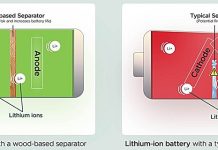
At The University of Texas at Austin, researchers have created a groundbreaking sodium battery that significantly lowers the risk of fires—a concern that has grown as batteries become more prevalent in our daily lives.
Published in Nature Energy, this development is not only safer but also leverages more affordable and widely available materials.
Battery fires, though uncommon, have become more frequent with the widespread use of batteries. The team’s innovation lies in their use of a solid diluent made from a salt—specifically, sodium nitrate.
This choice enabled them to use a single, nonflammable solvent in the electrolyte, which is crucial for the battery’s charge-discharge cycle. This approach stabilizes the battery by reducing the risk associated with the multiple liquid solvents typically found in electrolytes.
These solvents can react unfavorably with the battery’s components over time, leading to degradation and potential safety hazards.
Sodium, the battery’s key ingredient, poses its own challenges due to its highly reactive nature. Such reactivity can cause the formation of dendrites, needle-like structures that can lead to short circuits, fires, or even explosions.
The research team’s breakthrough significantly mitigates these risks, offering a safer and more stable battery option.
Lead researcher Arumugam Manthiram, from the Cockrell School of Engineering’s Walker Department of Mechanical Engineering, emphasizes the reduced risk and enhanced stability of their sodium-based battery.
This innovation represents a cost-effective alternative to lithium-ion batteries, which are ubiquitous in modern electronic devices and electric vehicles.
The environmental and economic advantages of sodium over lithium are significant. Sodium is abundant in seawater, making it an accessible and environmentally friendly option.
In contrast, lithium mining is costly and associated with various environmental issues, such as groundwater depletion and pollution. Moreover, lithium-ion batteries often contain cobalt, a material primarily mined in the Democratic Republic of the Congo under conditions that raise concerns about human health and environmental impact.
Manthiram and his team have previously demonstrated a cobalt-free lithium-ion battery, continuing their efforts to develop more sustainable battery technologies.
The new sodium battery also demonstrates impressive performance, retaining 80% of its capacity after 500 charge cycles—a benchmark comparable to that of lithium-ion batteries used in smartphones.
This achievement underscores the potential of sodium batteries to match or even surpass the performance of their lithium-ion counterparts, without compromising on safety or cost.
The team’s research could also have implications for improving lithium-ion batteries, suggesting that similar techniques might be applied to these cells with different materials.
The sodium battery’s composition, free of both cobalt and lithium, includes 40% iron, 30% manganese, and 30% nickel, further contributing to its environmental and economic benefits.
This advancement in battery technology represents a significant step toward safer, more sustainable, and cost-effective energy storage solutions.
The research findings can be found in Nature Energy.
Copyright © 2024 Knowridge Science Report. All rights reserved.



